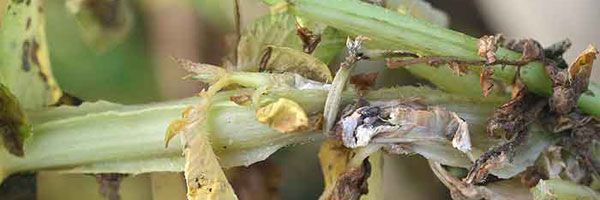
Sclerotinia spp.
(Stalk break and White mould disease)
- Causal agents and transmission
White mould disease, also named stalk break, is caused mainly by the fungus Sclerotinia sclerotiorum and, more rarely, by Sclerotinia minor, both of which can survive for several years in the soil in the form of resting sclerotia.
These fungi have a wide host range, including cultivated crops such as beans, peas, sunflowers, colza, other solanaceous species, and weeds.
Such a large host range contributes to the survival of the soil inoculum from season to season.
In moist soil conditions, the sclerotia form fruiting bodies that release numerous ascospores; these spores are spread by the wind and may be transported to potato stems or leaves.
After germination of the spores in humid conditions, the fungal mycelium penetrates the plant before colonising the vascular system. The infection of stem and leaves is more severe if the plants are damaged by the wind, hail or heavy rains.
In case of severe soil infestation, sclerotia may germinate directly and produce infectious mycelium which typically induces stem lesions at soil level.
- Significance
The disease occurs sporadically in Northern Europe and in temperate climates. It may be significant on dense foliage and in humid conditions related, for example, to the use of sprinkler irrigation and intensive fertilisation.





